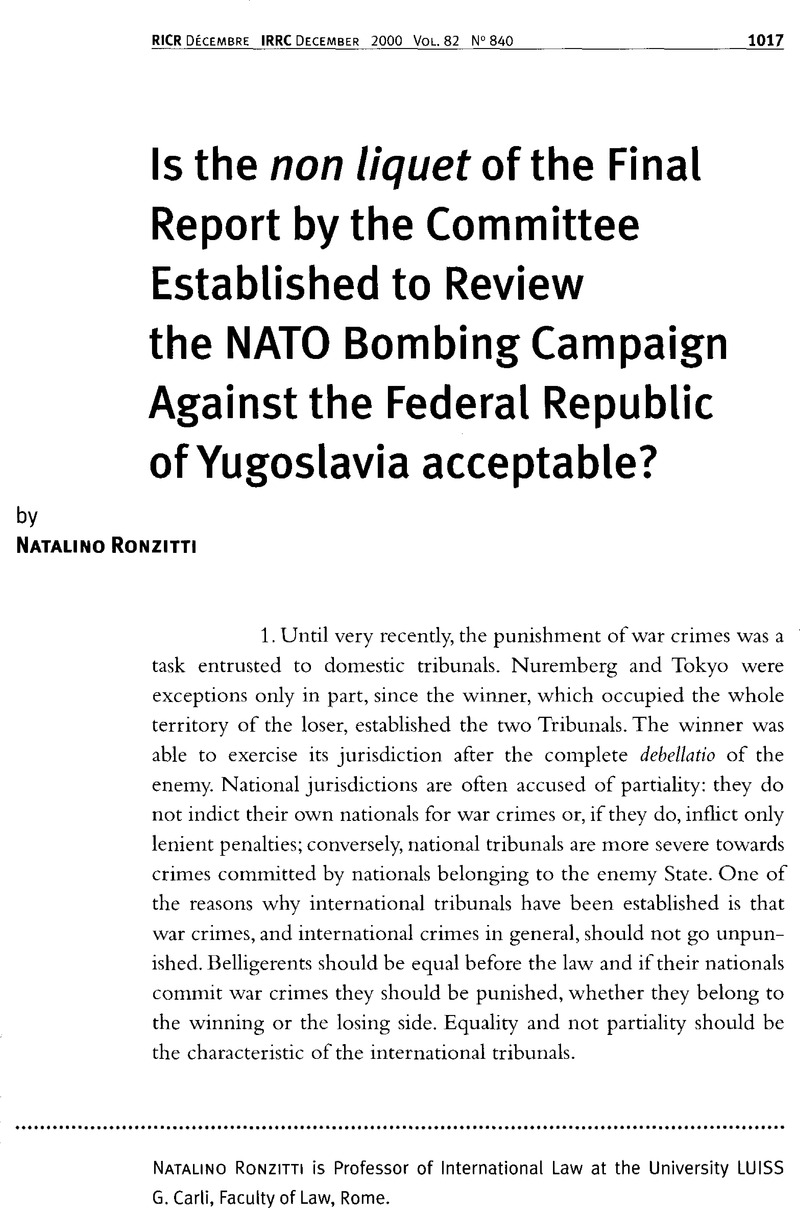Published online by Cambridge University Press: 27 April 2010

1 The US position is well explained by Scheffer, D. J., “The United States and the International Criminal Court”, American Journal of International Law, Vol. 93, 07 1999, pp. 12–22.CrossRefGoogle Scholar
2 Statute of the International Criminal Tribunal for the former Yugoslavia, Arts 1, 6 and 8.
3 Ibid., Arts 1 and 2 to 5.
4 See, for instance, the document submitted by a group of lawyers to the Office of the Prosecutor at http://jurist.law.pitt.edu/icty.htm and other material quoted by the Final Report, para. 6 (infra, note 6).
5 Legality of Use of Force, ICJ, Request for Provisional Measures, CR 99.
6 Final Report to the Prosecutor by the Committee Established to Review the NATO Bombing Campaign Against the Federal Republic of Yugoslavia (here-inafter Report), published on 13 June 2000. See <www.un.org/icty> or 39 ILM (2000), p. 1257.
7 A. Cassese, in La Re pubblica, 26 03 2000, p. 17Google Scholar. According to him, an “inquiry” is needed.
8 Protocol additional to the Geneva Conventions of 12 August 1949, and relating to the Protection of Victims of International Armed Conflicts (Protocol I), 8 June 1977.
9 See Arkin, W. M., “The environmental threat of military operations”, in Grunawalt, R. J., King, J. E. and McClain, R. S. (eds), International Law Studies 1996, Protection of the Environment During Armed Conflict, Vol. 69, Naval War College, Newport Rl, p. 128.Google Scholar
10 Legality of the Threat or Use of Nuclear Weapons, Advisory Opinion, ICJ Reports 1996, p. 226.Google Scholar
11 Ibid., para. 105 E, p. 265.
12 Ibid., para. 31, p. 242.
13 Report, para. 15.
14 Convention on the Prohibition of Military or any Other Hostile Use of Environmental Modification Techniques, 10 December 1976.
15 Report, para. 15.
16 Sandoz, Y., Swinarski, C., Zimmermann, B. (eds), Commentary on the Additional Protocols of 8 June 1977 to the Geneva Conventions of 12 August 1949, ICRC, Geneva, 1987, p. 632Google Scholar, note 3.
17 Report, para. 15.
18 See Annotated Supplement to the Commander's Handbook on the Law of Naval Operations, NWP 9A, Washington, D.C., 1989, p. 8–3Google Scholar and note 11). On the legality of targeting the Belgrade TV and radio station views differ. See e.g. Aldrich, G., “Yugoslavia's television studios as military objectives”, International Law FORUM du droit international, vol. I, No. 3, 1999, pp. 149–150CrossRefGoogle Scholar; McCoubrey, H., “Kosovo, NATO and international law”, International Relations, Vol. XIV, No. 5, 1999, p. 40Google Scholar; Rowe, P., “Kosovo 1999: The air campaign. Have the provisions of Additional Protocol I withstood the test?”, IRRC, No. 837, 03 2000, pp. 156–157Google Scholar; Amnesty International, NATO/Federal Republic of Yugoslavia, “Collateral Damage” or Unlawful Killings? Violations of the Laws of War by NATO during Operation Allied Force, 06 2000, pp. 46–53.Google Scholar
19 Report, para. 58.
20 Report, para. 62.
21 Ibid.
22 Report, para. 5.
23 Case No: IT-95–16-T, 14 January 2000.
24 Report, para. 52.
25 See A. Roberts/R. Guelff, Documents on the Laws of War, 3rd. ed., Oxford University Press, 2000Google Scholar, for the text of the declaration made on signature or ratification of Protocol I, e.g. by Belgium (p. 501), Germany (p. 504), Italy (p. 506), the Netherlands (p. 508) or the United Kingdom (p. 510).
26 Report, para. 5.